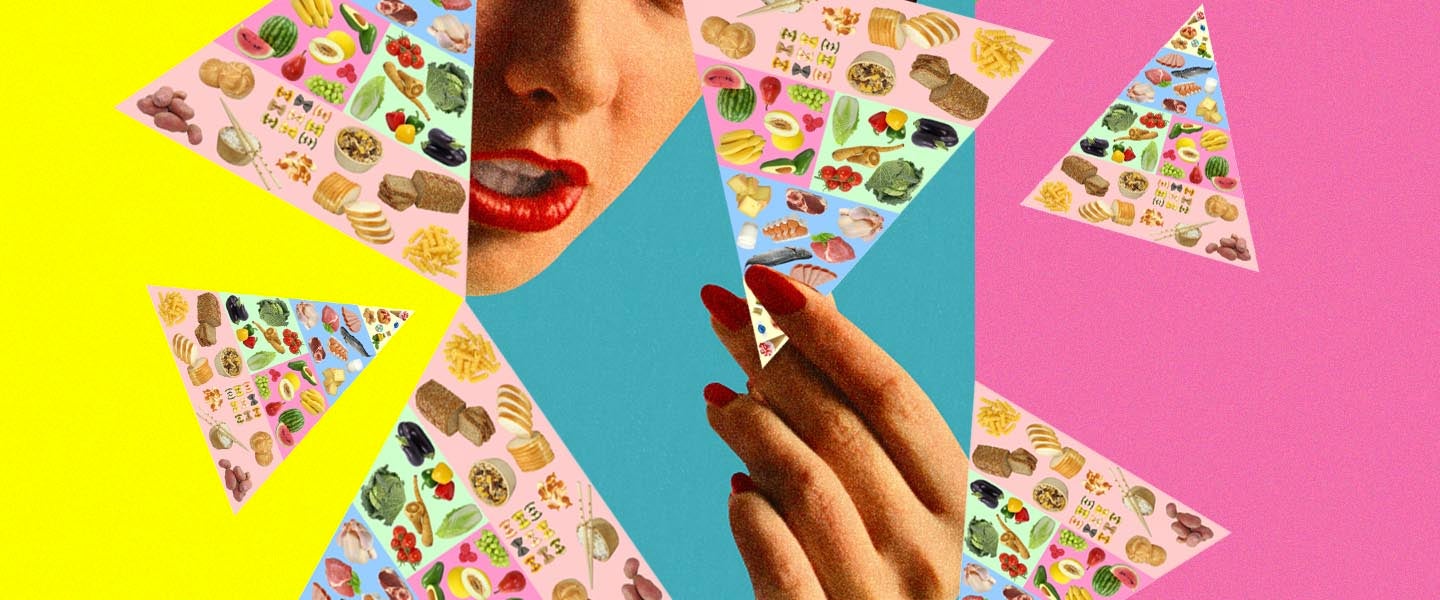Victoria, a 25-year-old product developer in London, has struggled with an eating disorder for most of her adult life. She would punish herself for mistakes by not eating and restrict certain foods for very specific reasons, which lead to an official diagnosis. Then, when she was browsing the internet about a year ago, she came across the concept of intuitive eating. “Initially the base principles were very helpful, including the idea that I needed to ‘reset’ myself and my approach to food,” she says. “I realized a lot of my bad habits around food weren’t decisions I was beholden to and I have the capacity to change them.”
Intuitive eating isn’t a new idea — it’s been around since dietitians Elyse Resch and Evelyn Tribole published Intuitive Eating: A Revolutionary Program That Works in 1995 — but it’s having a renaissance in these ostensibly body-positive times, with introductory guides being published recently in Vice, NPR and The Cut. As for what it is, Intuitive eating is an “anti-diet” that aims to undo the damage caused by diet culture and restore in its adherents the relationship with food they had as babies: eating when they’re hungry, stopping when they’re full and bringing no fixed rules or judgments to the various food types. “At such a young age, we learn to ignore our bodies signals,” says Samantha Gollup, a registered dietitian at the University of Wisconsin Hospitals and Clinics. “The ‘clean plate club,’ for instance, tells us to ignore our feelings of fullness, and so we learn to overeat regularly.”
For an intuitive eater, there’s no such thing as “good” or “bad” foods — Resch and Tribole don’t even like the term “junk food,” preferring the less judgmental “play food” — and adherents are encouraged to eat, well, whatever they like. Obviously allergens and foods that can’t be consumed for medical reasons are an exception, and Gollup says vegetarians and vegans can fit into the intuitive-eating scheme depending on whether “they’re vegan or vegetarian for the right reasons.” “If they believe in it from an ecological perspective,” she explains, “that’s different to having an eating disorder that they’re covering up by restricting.” (That some people do use veganism as a socially acceptable cover for their eating disorders is well-documented.)
If the idea of no “bad foods” sounds like it will inevitably lead to a diet comprised exclusively of pizza, ice cream, beer and candy, Resch and Tribole use the image of a toddler — who doesn’t yet have shame around dessert — leaving half a cookie on their plate as an illustration of our natural restraint. “How many adults do you know who’ll eat half a cookie?” Resch and Tribole ask in their practical guide to intuitive eating, the point being that as soon as something is entirely permissible, it loses its illicit appeal. Bodies tend not to prefer to eat foods comprised of refined sugar, artificial flavors and saturated fat constantly, the theory goes — although they might want these foods from time to time, and for the intuitive eater, that’s a non-event that involves no guilt.
That’s the goal, anyway, and it’s a long game. It takes time for individuals to recalibrate their relationship with food to a point where previously forbidden foods don’t hold an irresistible allure, and so overeating, or returning to a diet mentality, can occur in the initial stages. “For a while, I absolutely was eating a whole family-sized bar of chocolate every week, often over two sittings, because on some level I was still treating it like ‘naughty’ food,” says Stephanie, a 36-year-old communications advisor from New Zealand. “Eating it was still a guilty act, and so I’d binge past the point of being full or feeling ill. I had to learn to be chill about that, too, and not write myself off as irredeemable or think that eating intuitively was a doomed project.”
This process of self-forgiveness means Stephanie is now at a point where chocolate holds no special power over her. “Now we’ll often buy chocolate on our regular grocery trip and it will sit in the pantry, forgotten, until I’m making a cup of tea and want something to nibble on,” she says. “But that took more than a year.”
Intuitive eating strikes many people, especially those who have been on calorie-restricting diets for years, as difficult, and initially, plenty of them aren’t able to “hear” what their bodies are telling them. “I realized my innate sense of food intuition is broken,” Victoria explains. “Intuitive and healthy eating isn’t just a matter of realizing you don’t have to punish yourself for eating a family pack of chips.” She says that her mother’s attitude to food — which involved being “on every fad diet under the sun” and claiming that a low-fat yogurt and granola at about 11 a.m. kept her full until well after 4 o’clock — feels deeply ingrained in her, and “wired into [her] brain.” “Even now, if a yogurt doesn’t keep me full for several hours, I’ll be disappointed,” she says, “as if it’s a failing on my body’s part.”
This is the diet mentality that many would-be intuitive eaters have to overcome, which is why some individuals have to (re)learn how to identify when they’re hungry and full, and the reasons they might eat when they aren’t hungry. There are “waste-not unconscious eaters,” Resch and Tribole say, who will eat, rather than throw away or refrigerate unwanted food; “emotional unconscious eaters,” who eat when they’re bored or sad; and “chaotic eaters,” who are so busy during the day that they ignore their hunger signals until they’re over-hungry, and who often overeat food they don’t really feel like as a result. Intuitive eating, then, is a battle against messages around food imparted by our parents, friends and coworkers — and, increasingly, our Instagram feeds — where deprivation is seen as admirable and where we’re told the difference between how we are now and the “perfect body” is only a matter of willpower.
Intuitive eating, though, isn’t meant to be a weight-loss plan, despite sometimes being billed that way. Some people will lose weight when they eat intuitively and others will gain it, but what proponents promise is that your body will eventually find its “natural weight” or “set weight.” Resch and Tribole direct that, even if weight loss is a goal, it needs to be put on the back burner until the individual has learned to eat intuitively, otherwise it will “contaminate” that person’s eating choices.
Of course, there are quite a few assumptions built into the intuitive-eating model, including that the individual is in a position to eat what they most feel like, rather than whatever is cheapest, calorie-dense enough to survive on, requires the least time to prepare or is served to you as a prisoner or resident of a hospital or retirement facility. Kate, a 32-year-old marketing director in New York City who has tried and struggled with intuitive eating, says she sees our “alcohol-fueled social lives, the abundance of bad food, increased productivity and responsibility demands and lack of nutrition fundamentals” as serious structural barriers. Gollup, too, acknowledges this difficulty, and says that when people are really busy or their work doesn’t allow for breaks, people “may not have time to listen to their bodies or have time to actually eat a meal when they’re hungry.”
In other words, the fact that we’re generally such unintuitive eaters isn’t simply a problem with individual choice, but also a social problem. If we’re serious about encouraging more people to eat intuitively, that also requires a commitment to tackling related problems like food insecurity, poverty, inaccessible healthcare and the erosion of our free time and other employment rights. “I’ve come to the ultimate conclusion that nothing about our food environment is intuitive,” Kate laments. “When I try to eat intuitively, it’s like shoving a square peg into a round hole.”
For all of these personal and structural reasons, intuitive eating is a lofty goal, but Gollup insists it’s worth pursuing anyway. “Almost all people would benefit from intuitive eating,” she explains. “Because it’s all about listening to our bodies and having a healthier relationship with food.”

